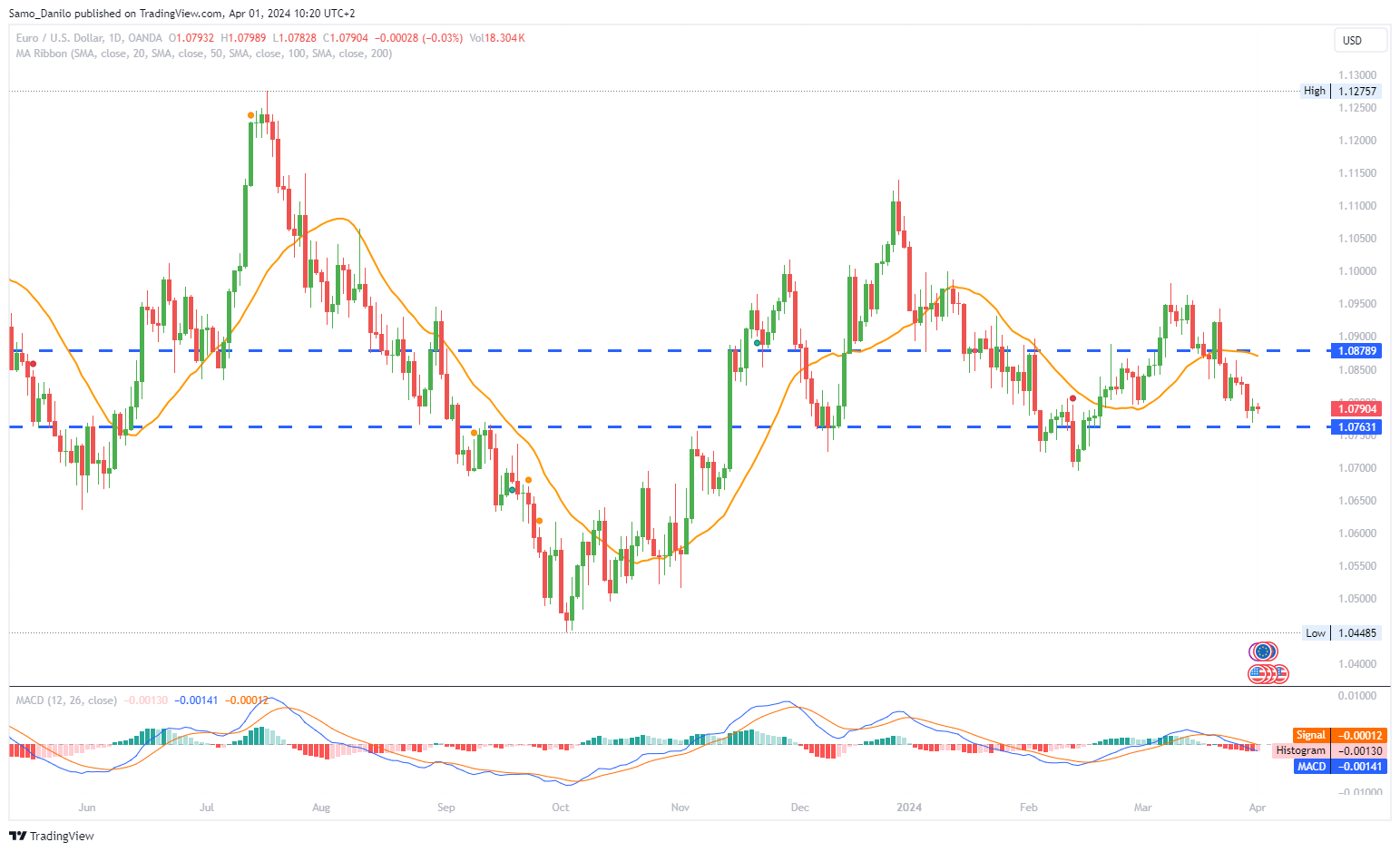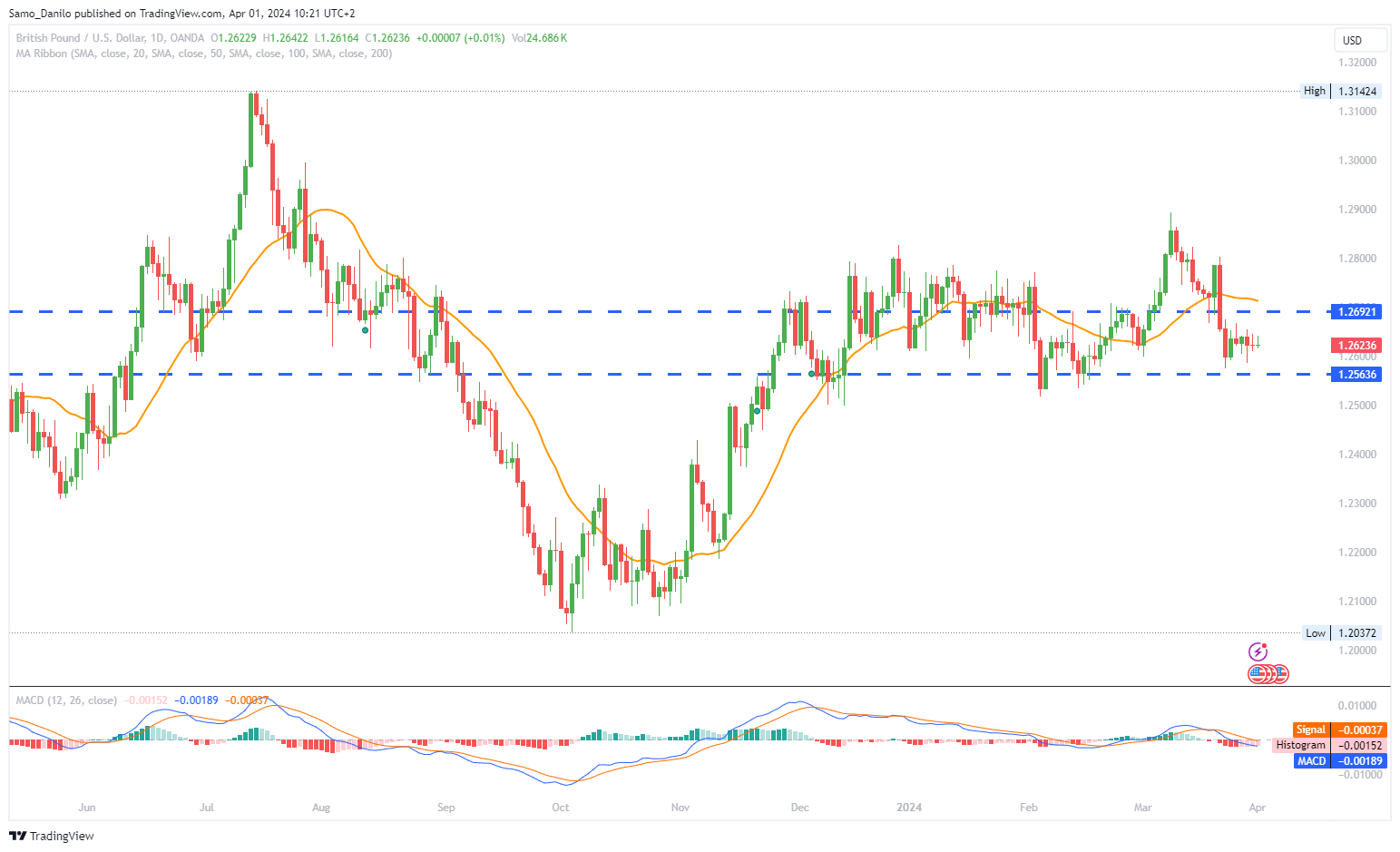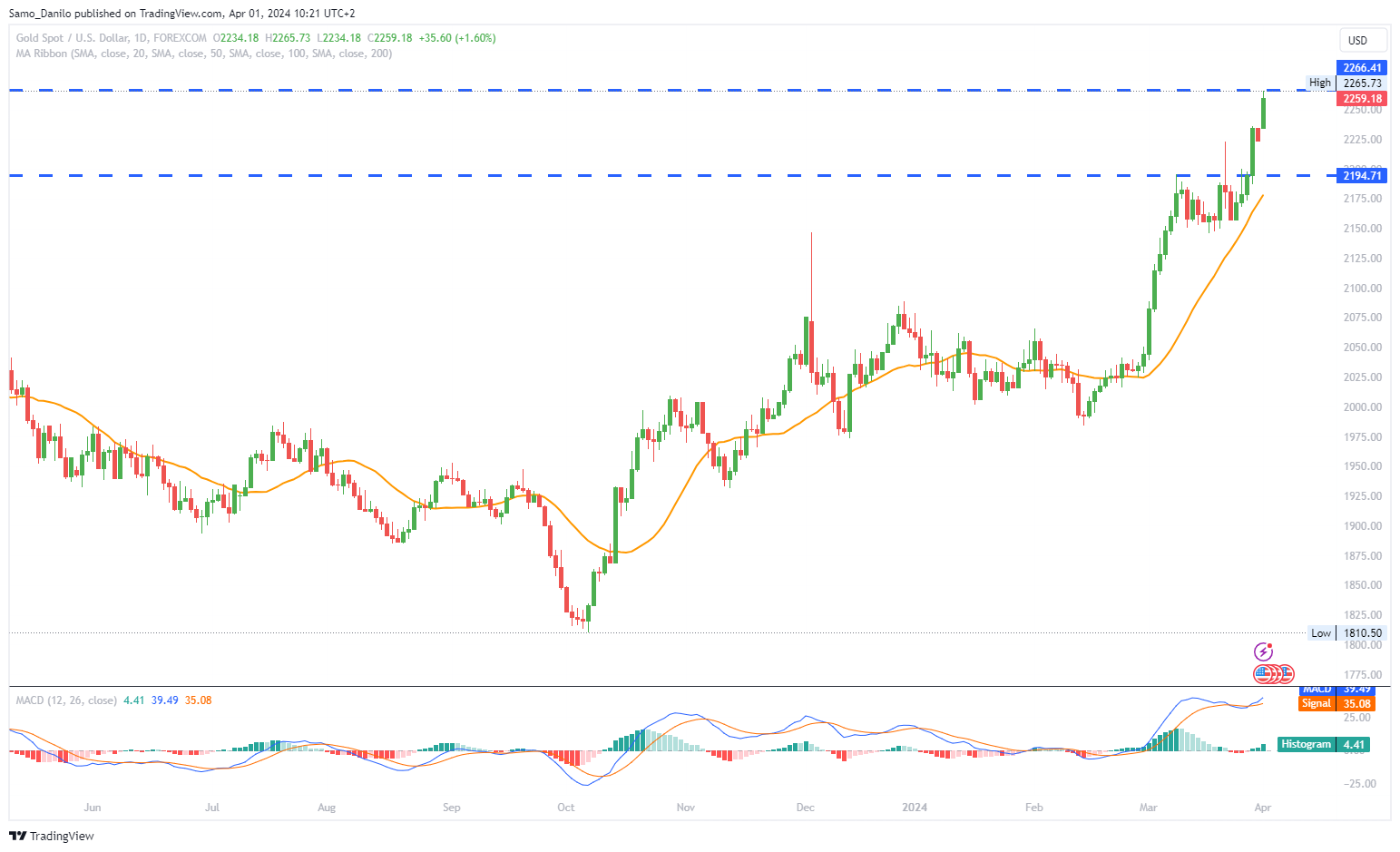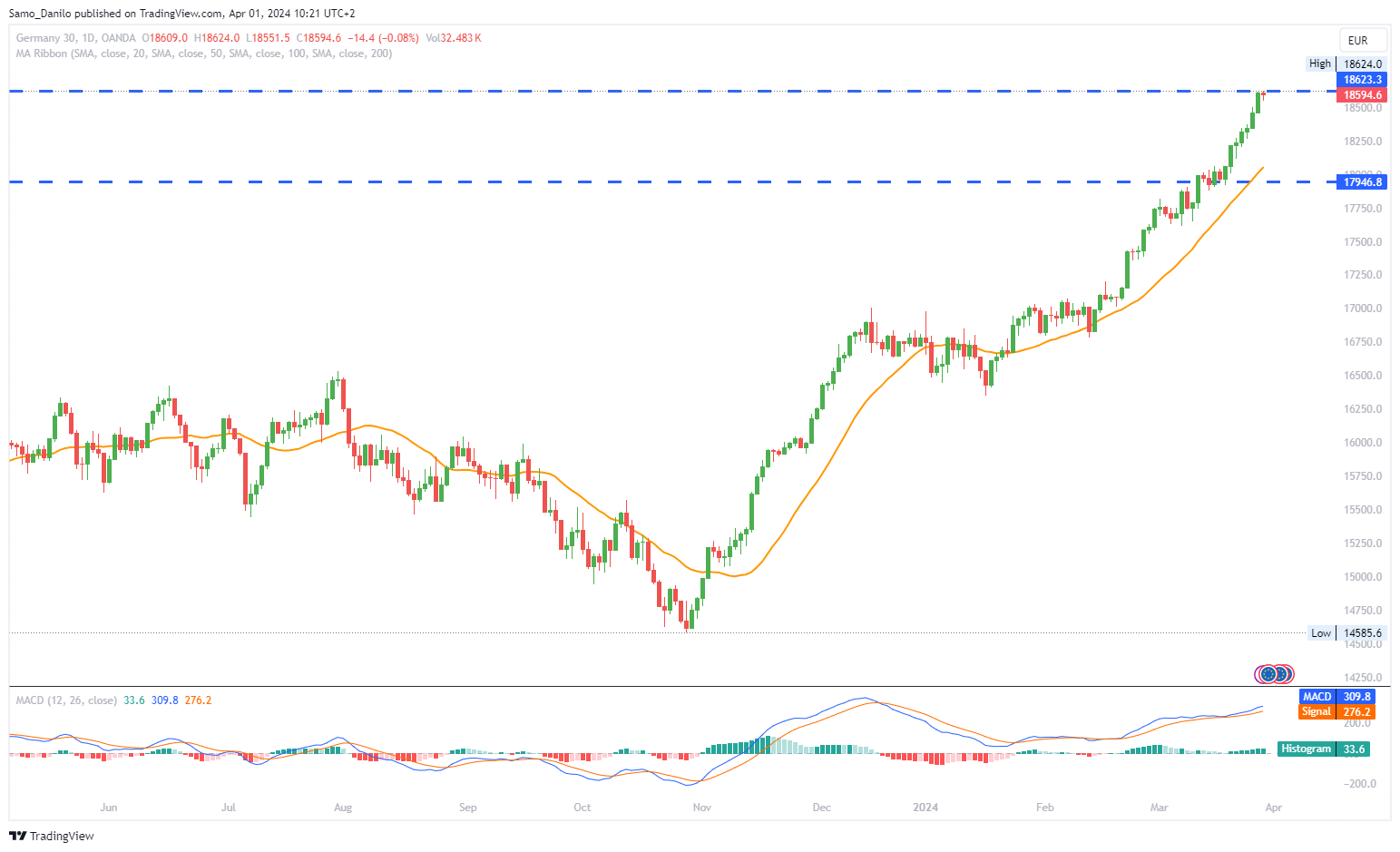EURUSD
- Stable Sideways Movement: EUR/USD maintains a sideways trend in early Europe on Easter Monday, lacking clear direction amid thin liquidity conditions and a subdued US Dollar market.
- Divergent Central Bank Policies: The US Dollar receives support from hawkish comments by Federal Reserve (Fed) Governor Chris Waller, indicating no immediate rush to cut rates. Conversely, ECB Governing Council member Yannis Stournaras suggests the possibility of four interest rate cuts totaling 100 basis points in 2024.
- ECB's Rate Cut Speculation: ECB policymaker Robert Holzmann adds to the speculation by suggesting that Europe could potentially cut interest rates before the US, highlighting the divergent monetary policy paths between the ECB and the Fed.
- Upcoming Economic Data: Market participants await the US ISM Manufacturing PMI release on Monday, expected to rise to 48.4 in March. Additionally, Tuesday brings the release of the German Consumer Price Index (CPI), providing further insights into the economic landscape.
- Impact of Central Bank Guidance: The contrasting guidance from the ECB and the Fed regarding interest rate cuts shapes investor sentiment and influences the EUR/USD exchange rate. Market participants closely monitor economic data releases for clues on future monetary policy decisions.
Closing statement: EUR/USD maintains a stable sideways movement amid thin liquidity conditions and contrasting guidance from the ECB and the Fed regarding interest rate cuts. Speculation surrounding potential rate cuts in Europe and upcoming economic data releases contribute to market uncertainty, shaping the direction of the currency pair in the near term.
GBPUSD
- Stagnant Trading: GBP/USD exhibits a lackluster performance above the 1.2600 level in European trading on Easter Monday, finding some support from a subdued US Dollar market.
- Fed's Stance on Rate Cuts: Federal Reserve (Fed) Governor Christopher Waller's comments on Wednesday indicate the central bank's cautious approach towards rate cuts, citing sticky inflation data. This stance suggests a potential delay in the implementation of rate reductions to support inflation reaching the 2% target.
- Powell's Remarks: Fed Chairman Jerome Powell reinforces the central bank's position on potential interest rate cuts throughout 2024, citing recent US inflation data aligning with expectations.
- US PCE Data: February's US Core Personal Consumption Expenditures (PCE) data reveals a 0.3% month-over-month (MoM) increase, meeting market expectations but slightly lower than January's figure.
- BoE Rate Cut Speculation: Anticipation of the Bank of England (BoE) implementing three quarter-point rate reductions in 2024 exerts downward pressure on the Pound Sterling (GBP), contributing to the currency pair's subdued performance.
| SMA (20) | Slightly Falling |
| |
| RSI (14) | Falling |
|
|
| MACD (12, 26, 9) | Falling |
|
|
Closing statement: GBP/USD exhibits stagnant trading above the 1.2600 level amid a subdued US Dollar market and contrasting central bank stances on interest rate cuts. While the Fed adopts a cautious approach driven by sticky inflation data, the Bank of England's anticipated rate cuts in 2024 weigh on the Pound Sterling. Market participants closely monitor economic data releases and central bank communications for further insights into the currency pair's future direction.
GOLD
- Record Highs: Gold price achieves a new record peak as investors increasingly anticipate a June Fed rate cut, bolstering demand for the safe-haven asset.
- Defensive US Dollar: The US Dollar remains on the defensive, buoyed by optimism at the start of the new quarter, particularly after positive Manufacturing and Services PMI data from China in March.
- Expectations of Fed Rate Cut: Heightened expectations that the US Federal Reserve (Fed) will initiate interest rate reductions in June, supported by Friday's US Personal Consumption Expenditures (PCE) Price Index, contribute to downward pressure on the US Dollar, providing support for gold price.
- Key Data Ahead: Market participants await the release of US Nonfarm Payrolls data on Friday, which will play a crucial role in solidifying expectations for a June Fed rate cut. This data will heavily influence both the US Dollar's value and the direction of gold price.
- Market Dynamics: The return of full trading activity in the US following the Easter weekend break may prompt profit-taking in gold price as traders adjust their positions ahead of the US employment data throughout the week.
| SMA (20) | Rising |
|
| |
| RSI (14) | Rising |
|
| |
| MACD (12, 26, 9) | Rising |
|
|
|
Closing statement: Gold price surges to new highs driven by mounting expectations for a June Fed rate cut, while the US Dollar remains defensive amid positive sentiment in the markets. Anticipation of monetary policy easing by the Fed supports gold price, with investors closely monitoring upcoming US Nonfarm Payrolls data for further insights. Additionally, the return of full trading activity in the US could trigger short-term adjustments in gold price as market participants position themselves ahead of key economic data releases.
CRUDE OIL
- West Texas Intermediate (WTI) oil price continues its upward trend, reaching around $83.70 per barrel in Asian trading hours on Monday.
- Investors are focused on the upcoming OPEC+ joint ministerial meeting, where market fundamentals and production targets will be assessed, with expectations for the continuation of current output policies.
- Russian Deputy Prime Minister Alexander Novak emphasized the importance of reducing output over exports in the second quarter to align with OPEC+ targets.
- Ukrainian drone strikes have damaged several Russian refineries, resulting in a reduction in fuel exports and the loss of approximately 1 million barrels per day of Crude processing capacity.
- Analysts at Goldman Sachs reported that oil demand in Europe surpassed expectations, showing a year-on-year increase of 100,000 barrels per day in February, contrary to earlier projections of a 200,000-bpd decline for 2024.
| SMA (20) | Rising |
|
|
| RSI (14) | Rising |
|
|
| MACD (12, 26, 9) | Slightly Rising |
|
Closing statement: With WTI oil prices rising and attention on the upcoming OPEC+ meeting, market sentiment remains positive despite challenges such as geopolitical tensions and refinery disruptions. Analysts anticipate continued volatility in the Crude oil market as demand dynamics and supply disruptions unfold.
DAX
- Germany stocks exhibited a mixed performance on Friday, with gains in the Food & Beverages, Media, and Consumer & Cyclical sectors driving shares higher, while losses in the Construction, Transportation & Logistics, and Software sectors led to declines.
- At the close in Frankfurt, the DAX index rose by 0.15% to achieve a new all-time high, while the MDAX index experienced a slight loss of 0.07%, and the TecDAX index saw a modest increase of 0.02%.
- The DAX volatility index, reflecting the implied volatility of DAX options, rose by 3.74% to reach 12.77.
- Among the top performers on the DAX were Siemens Energy AG, Merck KGaA, and Rheinmetall AG, which rose by 3.03%, 2.12%, and 1.84%, respectively.
- Conversely, Deutsche Post AG NA O.N., Dr Ing hc F Porsche AG Preferred, and Brenntag AG were among the session's worst performers, declining by 1.42%, 1.37%, and 1.06%, respectively, by the close.
| SMA (20) | Rising |
|
|
| RSI (14) | Rising |
|
|
| MACD (12, 26, 9) | Rising |
|
|
Closing statement: The DAX index reached a new all-time high despite mixed performance across sectors, with gains in Food & Beverages and Media contributing to the uptrend. While volatility increased slightly, notable performers like Siemens Energy AG and Merck KGaA drove positive momentum, while others like Deutsche Post AG NA O.N. faced declines. As investors continue to monitor market movements, the DAX remains poised for further developments in the coming sessions.




